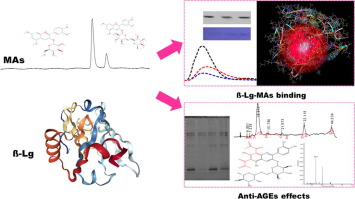当前位置:
X-MOL 学术
›
Bioorgan. Chem.
›
论文详情
Our official English website, www.x-mol.net, welcomes your
feedback! (Note: you will need to create a separate account there.)
Mulberry anthocyanins exert anti-AGEs effects by selectively trapping glyoxal and structural-dependently blocking the lysyl residues of β-lactoglobulins.
Bioorganic Chemistry ( IF 4.5 ) Pub Date : 2020-01-25 , DOI: 10.1016/j.bioorg.2020.103615 Ibrahim Khalifa 1 , Du Xia 2 , Kunal Dutta 3 , Jinmeng Peng 2 , Yangyang Jia 2 , Chunmei Li 4
Bioorganic Chemistry ( IF 4.5 ) Pub Date : 2020-01-25 , DOI: 10.1016/j.bioorg.2020.103615 Ibrahim Khalifa 1 , Du Xia 2 , Kunal Dutta 3 , Jinmeng Peng 2 , Yangyang Jia 2 , Chunmei Li 4
Affiliation

|
Advanced glycation end-products (AGEs), which instigate many disorders, are mostly mediated by dicarbonyl rearrangements. We studied the corresponding mechanisms of the anti-glycation effects of two anthocyanins purified from mulberry fruits, namely cyanidin 3-glucoside (C3G) and cyanidin 3-rutinoside (C3R), on glycated β-lactoglobulins (β-Lg). Both mulberry anthocyanins (MAs) inhibited the AGEs-formation in a dose-dependent manner, but the effect of C3R was significantly stronger than that of C3G (p < 0.05). MAs inhibited AGEs-formation by selectively trapping dicarbonyls, especially glyoxal. The UPLC-ESI-Q-TOF-MS results characterized that C3R formed mono- and di-glyoxal adducts, where C3G only created di-glyoxal adducts. Additionally, C3R could directly interact with some of the glycation sites of β-Lg. Overall, GO-trapping and β-Lg-MAs covalent/noncovalent binding are disclosed as the key mechanisms of the anti-AGEs activity of MAs on β-Lg, which could be valorised as effectual AGEs inhibitors in proteins-rich matrices.
中文翻译:

桑树花色苷通过选择性地捕获乙二醛和结构依赖性地阻断β-乳球蛋白的赖氨酰残基而发挥抗AGEs的作用。
导致许多疾病的晚期糖基化终产物(AGEs)主要由二羰基重排介导。我们研究了从桑树果实中纯化的两种花色苷,即花青素3-葡萄糖苷(C3G)和花青素3-芸苔苷(C3R)对糖化β-乳球蛋白(β-Lg)的抗糖化作用的相应机理。两种桑树花色苷(MAs)均以剂量依赖性方式抑制AGEs的形成,但C3R的作用明显强于C3G(p <0.05)。MA通过选择性地捕获二羰基,尤其是乙二醛来抑制AGEs的形成。UPLC-ESI-Q-TOF-MS结果表明,C3R形成了单-和二-乙二醛加合物,而C3G仅形成了二-乙二醛加合物。此外,C3R可以直接与β-Lg的某些糖基化位点相互作用。总体,
更新日期:2020-01-26
中文翻译:

桑树花色苷通过选择性地捕获乙二醛和结构依赖性地阻断β-乳球蛋白的赖氨酰残基而发挥抗AGEs的作用。
导致许多疾病的晚期糖基化终产物(AGEs)主要由二羰基重排介导。我们研究了从桑树果实中纯化的两种花色苷,即花青素3-葡萄糖苷(C3G)和花青素3-芸苔苷(C3R)对糖化β-乳球蛋白(β-Lg)的抗糖化作用的相应机理。两种桑树花色苷(MAs)均以剂量依赖性方式抑制AGEs的形成,但C3R的作用明显强于C3G(p <0.05)。MA通过选择性地捕获二羰基,尤其是乙二醛来抑制AGEs的形成。UPLC-ESI-Q-TOF-MS结果表明,C3R形成了单-和二-乙二醛加合物,而C3G仅形成了二-乙二醛加合物。此外,C3R可以直接与β-Lg的某些糖基化位点相互作用。总体,











































 京公网安备 11010802027423号
京公网安备 11010802027423号